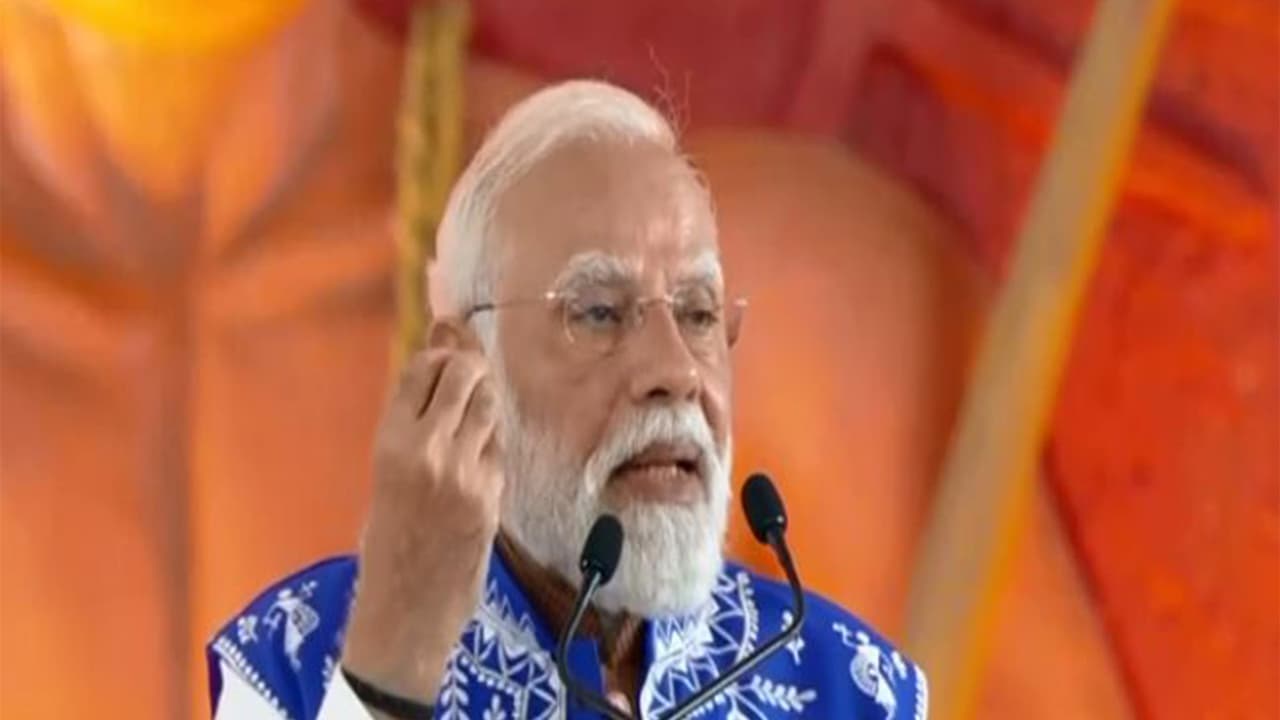PM Modi addressed the Janjatiya Gaurav Diwas in Gujarat, marking Birsa Munda’s 150th anniversary. He launched projects worth Rs 9,700 crore, emphasized tribal welfare, and reviewed the Mumbai-Ahmedabad Bullet Train project.
Prime Minister Narendra Modi on Saturday addressed the Janjatiya Gaurav Diwas programme, marking the 150th Birth Anniversary celebration of Dharti Aaba Bhagwan Birsa Munda, in Dediapada, Gujarat and inaugurated and laid the foundation stone of various infrastructure and development projects worth over Rs 9,700 crore.
PM Hails Tribal Pride and Cultural Preservation
He said tribal pride has been an integral part of India’s consciousness for thousands of years and whenever the nation’s honour, self-respect, and freedom were at stake, the tribal communities stood at the forefront. “We cannot forget the contribution of the tribal community in the freedom movement,” he said.
Noting that Shri Govind Guru Chair for Tribal Language Promotion Centre has also been inaugurated today, PM Modi said this centre will study the dialects of tribal communities such as Bhil, Gamit, Vasava, Garasia, Kokani, Santhal, Rathwa, Nayak, Dabla, Chaudhary, Kokna, Kumbhi, Warli, and Dodia. He said stories and songs associated with these communities will be preserved.
Commitment to Tribal Welfare and Development
The Prime Minister said that sickle cell disease has long posed a serious threat to tribal communities and to combat this, the number of dispensaries, medical centres, and hospitals in tribal regions has been significantly increased. He said a nationwide campaign is currently underway to address and manage sickle cell disease effectively.
PM Modi stated that the nation today possesses the strength of the mantra ‘Sabka Saath, Sabka Vikas’. He remarked that this mantra has transformed the lives of crores of people over the years, strengthened national unity, and brought the long-neglected tribal communities into the mainstream. On the occasion of the 150th birth anniversary of Birsa Munda, the Prime Minister called upon people to reaffirm their commitment to this mantra. He emphasised that no one should be left behind in development and said this is the true tribute to Dharti Aaba. “Together, we will move forward and fulfil the dream of a developed India and with this resolve,” he said.
BJP’s Focus on Tribal Empowerment
PM Modi said that his government has taken several steps to empower the tribal community. He said that for any community to progress, its true participation in democracy is equally important. “Therefore, our commitment is to ensure that our tribal brothers and sisters reach high positions in the country and lead the nation. Today, the country’s President is a tribal woman. Similarly, the BJP and the NDA have always worked to elevate our promising tribal colleagues to high positions. Today, Chhattisgarh’s Chief Minister, Vishnu Deo Sai, from our Tribal community, is transforming Chhattisgarh. In Odisha, Mohan Charan Majhi, from the tribal community, is developing Odisha with the blessings of Lord Jagannath,” he said.
“In Arunachal Pradesh, our tribal brother Pema Khandu serves as Chief Minister. In Nagaland, our tribal brother Neiphiu Rio is working as the Chief Minister… Our Gujarati brother, Mangubhai Patel, is the Governor of Madhya Pradesh. In the central government, Sarbananda Sonowal belongs to the tribal community and is managing the entire shipping ministry,” he added.
Contrast with Past Governments
PM Modi accused the Congress governments of neglecting the tribal community during its rule. “For six decades, the Congress governments left tribal communities to fend for themselves. Malnutrition persisted, education was scarce, and these shortcomings became the unfortunate identity of many tribal regions. Congress governments remained indifferent. For BJP, tribal welfare has always been a priority. We have moved forward with a firm resolve to end the injustice faced by our tribal brothers and sisters,” he said.
PM Reviews Ambitious Bullet Train Project
Earlier in the day, PM Modi visited the under-construction Bullet Train Station in Surat to review the progress of the Mumbai-Ahmedabad High-Speed Rail Corridor (MAHSR) — one of India’s most ambitious infrastructure projects symbolizing the nation’s leap into the era of high-speed connectivity.
MAHSR Corridor: Scale and Progress
The MAHSR spans approximately 508 kilometres, covering 352 km in Gujarat and Dadra and Nagar Haveli, and 156 km in Maharashtra. The corridor will connect major cities including Sabarmati, Ahmedabad, Anand, Vadodara, Bharuch, Surat, Bilimora, Vapi, Boisar, Virar, Thane, and Mumbai, marking a transformative step in India’s transportation infrastructure. Built with advanced engineering techniques on par with international standards, the project features 465 km (about 85% of the route) on viaducts, ensuring minimal land disturbance and enhanced safety. So far, 326 km of viaduct work has been completed, and 17 out of 25 river bridges have already been constructed.
Economic Boost and Sectional Progress
Upon completion, the Bullet Train will reduce travel time between Mumbai and Ahmedabad to nearly two hours, revolutionizing inter-city travel by making it faster, easier, and more comfortable. The project is expected to boost business, tourism, and economic activity along the entire corridor, catalyzing regional development. The Surat-Bilimora section, covering around 47 km, is in an advanced stage of completion, with civil works and track-bed laying fully completed.
Surat Station: Design and Connectivity
The design of the Surat station draws inspiration from the city’s world-renowned diamond industry, reflecting both elegance and functionality. The station has been designed with a strong focus on passenger comfort, featuring spacious waiting lounges, restrooms, and retail outlets. It will also offer seamless multi-modal connectivity with the Surat Metro, city buses, and the Indian Railways network. (ANI)
(Except for the headline, this story has not been edited by Asianet Newsable English staff and is published from a syndicated feed.)
